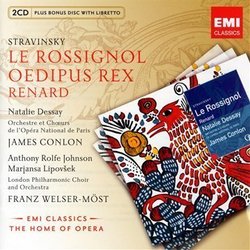| All Artists: James Conlon, Natalie Dessay Title: Stravinsky: Le Rossignol/Oedipus Rex (2 CD/CD-ROM) Members Wishing: 0 Total Copies: 0 Label: EMI Classics Original Release Date: 1/1/2010 Re-Release Date: 4/20/2010 Genre: Classical Style: Number of Discs: 3 SwapaCD Credits: 3 UPC: 5099945650024 |
Search - James Conlon, Natalie Dessay :: Stravinsky: Le Rossignol/Oedipus Rex (2 CD/CD-ROM)
 | James Conlon, Natalie Dessay Stravinsky: Le Rossignol/Oedipus Rex (2 CD/CD-ROM) Genre: Classical
"One great quality of Conlon's performance is that he emphasises the miniature opera's straddling of two expressive worlds. ... With the arrival of the exceptionally beautiful tenor voice of Vsevolod Grivnov as the Fisherm... more » |
Larger Image |
CD Details
Synopsis
Album Description
"One great quality of Conlon's performance is that he emphasises the miniature opera's straddling of two expressive worlds. ... With the arrival of the exceptionally beautiful tenor voice of Vsevolod Grivnov as the Fisherman you strongly suspect that this is the recording The Nightingale has been waiting for. Natalie Dessay is lovely in the title-role." Synopsis The eclectic and daring nature of Stravinsky's genius is evident in these three contrasting works. Le Rossignol is based on Hans Christian Andersen's tale of the nightingale, portrayed by a virtuoso coloratura soprano; the bird delights the Chinese emperor, but is then replaced by a bejewelled automaton. When the Emperor falls mortally ill, the nightingale returns, charms Death and saves the Emperor's life. The colourful score moves from the fairy-tale Romanticism of Act 1 (written in 1907) to a more modernist style for the subsequent two acts (written in 1914). Renard, written in 1916, but not staged till 1922, is a one-act chamber work with a pulsing score which integrates elements of Russian folk music, notably the extensive use of repeated motifs and an often chant-like vocal line. Dance plays an important role in telling the story of the cunning fox who tricks a cockerel, a cat and a ram. Dating from 1927, Oedipus Rex, both compact and monumental, is an oratorio-like work sung in Latin; a male chorus plays an important role, as does a spoken narration. It tells the classic story of Oedipus, the King of Thebes, who discovers that, unwittingly, he has killed his own father and married his own mother.

 Track Listings (21) - Disc #1
Track Listings (21) - Disc #1